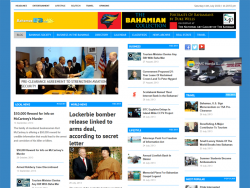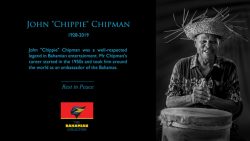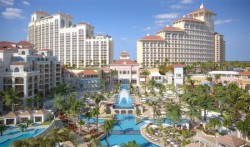The arrest of nine Bahamian straw vendors in New York City on charges of trafficking in counterfeit goods is not a problem for the Bahamas. It is, however, a symptom of much larger problems.
And building a new $10 million straw market will probably not solve those problems.
First off, why do we call them “Bahamian straw vendors”. Little of what they sell is actually made of straw and almost none of it is Bahamian-made. Many of the vendors aren’t even Bahamian.
A 2007 Nassau Institute survey of 42 Straw Market stalls found that 52 per cent of stalls surveyed sold no straw products, with only 13 per cent of products sold being Bahamian-made and only 19 per cent made of straw.
Further, the survey suggested that less than 5 per cent of the Bay Street straw market vendors were of Bahamian birth.
So, maybe it’s time to lose the “Bahamian straw vendors” reference and call them what they are… small independent retailers.
Public opinion on the arrest has been all over the map, with many conflicting opinions. Most people condemn the vendor’s actions but some have almost attempted to justify their actions, claiming they were “forced” into their illegal activities by economics.
Telator Strachan, president of the Straw Vendors Association defended the vendors, saying, “The vendors try to make an honest living with those bags. They bought them and were prepared to pay duty on the items.”
There is no doubt that the vendors knew what they were doing was wrong. Everyone else did.
In December, 2006, customs, immigration and police officers confiscated thousands of fake designer handbags, watches, clothes and other counterfeit items in a raid at an East St. South warehouse.
More than 5,000 Gucci, Prada, Louis Vuitton and Chanel handbags were among the plethora of false designer labels that were seized.
The alleged owner of the operation, 31-year-old Shan Ma, a Chinese national with residency status, claimed that he did not know the difference between counterfeit and real goods. Yeah, right!
Michael Moxey, from the Counterfeit Crime Division at the Royal Bahamas Police Force, said the public needs to realize that buying counterfeit items is a crime and offenders could be fined up to $100,000 or sentenced to five years in prison.
“Use this as an example to know that the laws do exist and they will be enforced,” he warned back then.
Obviously, sympathetic politicians made some phone calls and there has been little police action since, despite numerous expressions of concern by U.S. offcials.
This was a problem that had been in the making for a long time.
Back in 2005, the vendors wholeheardtedly rejected a plan by Trade and Industry Minister Leslie Miller to ensure that at least 50 percent of the items sold at the new downtown straw market are authentically Bahamian.
They indicated that even traditional straw works are being replaced by imported straw work, which is cheaper and of a higher quality.
They also complained that native crafts are much more expensive and have a limited selection.
Vendors, Ann Bailey and Mary Simmons, also lamented that authentic Bahamian items are too expensive.
Anita Francis, a veteran straw vendor said that she had no choice but to sell imported items to remain competitive and to feed her family.
“I am a mother and I sit down to my stall day after day without making a dollar. But when they started selling the [counterfeit] Louis Vuitton, Gucci, and Prada bags and I bought a few of them, then I started making money. The bags are now hot sellers, it’s what the tourists want, so we have to supply them,” she said.
In 2007, outraged by persistant sales of knock-off items, Nassau Tourism and Development Board Chairman Charles Klonaris said the Straw market had become nothing more than a flea market and was a liability to The Bahamas’ tourism industry.
He said the straw market slowly began going down hill when straw vendors opted to sell counterfeit products over authentic Bahamian straw and craftwork.
“For many years, the straw market has been an important anchor for Bay Street, but it’s been living on an image from the past where [vendors] were very creative in terms of [their] straw work and other local products they would create,” Mr. Klonaris told the Bahama Journal.
He said the market today resembles a flea market, where vendors are selling T-shirts, baseball caps, and knock-off designer handbags.
“We, the Nassau Tourism and Development Board, feel that the straw vendors for the good of the nation should recreate themselves and be more creative with more local arts and craft and straw work,” Mr. Klonaris said at the time.
Around the same time, Rick Lowe, from the Nassau Institute said the selling of counterfeit branded goods, such as luxury jewellery, perfumes and watches, Gucci and Fendi bags, and designer brands such as Nike, Adidas and Hilfiger, could land the Bahamas in trouble with US copyright and intellectual property watchdogs such as the International Intellectual Property Alliance (IIPA) the umbrella group for US trademark industries.
He said the Straw Market sales could again attract the unwanted attention of the US. He noted that the protection of intellectual property rights was a big component of any trade agreements – World Trade Organisation (WTO) membership and the Economic Partnership Agreement with the European Union (EU) – that The Bahamas was faced with negotiating.
“There are treaties where we’ve signed all sorts of things.” Mr Lowe said. “It can’t be in the country’s best interests to be flaunting the fact that you can buy these knock-offs here.”
In October 2008 the US Embassy even sponsored a workshop to help the Bahamas develop strategies to combat piracy of intellectual property in the Bahamas.
“The transit of counterfeit drugs, car and airplane parts through the Bahamas coupled with the lack of enforcement of copyright laws is a major concern and officials said the workshop is critical in raising awareness about the country’s piracy problem,” The Tribune reported on October 8, 2008.
And then there was the obvious warning at the beginning of this year when Americans let it be known that they were not satisfied that Bahamians were doing their best to get piracy under control.
The US Trade Representative’s office wrote in its report on the matter:
“However, enforcement is lax and anecdotal evidence suggests that the police are complicit in the buying and selling of pirated movies, songs and fabricated high-end purses to residents and tourists.”
Although there was no supporting evidence to implicate the police, it was obvious that the Americans had had enough.
So, the ladies in New York City knew they were breaking the law and took a chance that they would not get caught.
After the arrest of the vendors, Deputy Prime Minister and Minister of Foreign Affairs, Brent Symonette warned vendors, “As a result of these charges, I highly recommend that Bahamians be guided accordingly.”
Although sound advice, it was not received warmly by the PLP, or the vendors, who think that government should find some way for them to continue their illicit trade. To do otherwise, according to some, would mean financial collapse for them and the country.
Some vendors have gone so far as to delude themselves into thinking that their entire business model must be based on the sale of couterfeit goods.
Shop owner Lerond Colebrook recently told the Tribune newspaper: “If you take away the bags, you take away the food out of our mouth, or our customs officers, and for the tourists who come here excitedly for the bags.”
Vendor Phillipa Nixon said: “We went to selling knock off bags because we had to go with the flow with what was selling at the time, because straw products weren’t and still aren’t marketable.”
“Tourists were asking us about the knock off bags… This is what we live off of right now.”
“Why can’t we sell what is valuable to make money?”, she asked.
Wood carver James Rolle said, “If I was a vendor, as far as I’m concerned, once the government get the duty I could sell them anyway. You can’t tell me they’re illegal once you collect the duty.
“You go to the US to buy these fake items. Once you bring them to the Bahamas and pay government duty, they aren’t illegal any more.”
He’s dead wrong, of course. The bags are illegal all the way down the distribution pipeline, right down to the woman who buys it and carries it on her shoulder.
Just last week, Adrian Gibson, in a column in the Tribune, said the Straw Market has become a ghastly, national blemish.
“Nassau’s flea market–I mean straw market–has become a ghastly, national blemish that has irrefutably become a liability to our country’s tourism industry.”
Gibson points out that our declining tourist numbers indicate that the Bahamas’ tourism product is mediocre and significantly falling behind. He says the internationally promoted straw/flea market is also weakening our tourism product, as it has become nothing more than, “a filthy, condemned structure where illegal aliens profit and counterfeit merchandise is sold unabatedly.
“The present straw market is a major blot on downtown Bay Street that has, itself, become a loathsome and grimy monstrosity.
“In glory days, the straw market used to be a major tourist attraction. Today, it is nothing but a grubby, dusty zone where tourists are constantly harassed by overly aggressive vendors… where rats, roaches and other rodents are permanent residents. Frankly, it no longer reflects Bahamian culture.”
The old straw market, before the fire, was already in decline. In its “glory days”, it was an actual straw market, with straw vendors. It had charm, history and culture. It was “world famous” in that it was must-see for visitors to the country.
Will a new $10 million market change all that? It may be more difficult than one thinks to straighten the market out, as there are other problems with the whole straw market concept.
Despite its scathing report on the Straw Market, the Nassau Institute still said that the Government should not mandate what the straw vendors sold, as requiring them to sell only Bahamian-made products would put 90 per cent of them out of business.
That is true. And therein lies the bigger problem.
If vendors can’t sell counterfeit merchandise – their best selling, highest profit items – how will they make a living, even in a new $10 million building?
If the intention is to build a new market, populated by the same vendors, then there needs to be changes made to ensure that those vendors do not feel a need to resort to criminal activities to make an “honest living”.
What we have now is poor marketing and the lack of good old fashion business sense.
One of the biggest problems the straw vendors face, whether they operate from a tent or a fancy new building, is that most of them sell the same merchandise.
Dozens of stalls, all selling the same merchandise. It’s a matter of marketing. Not only are they not selling Bahamian-made items, they are all selling the same foreign-made trinkets and trash.
BAIC is churning out Bahamian crafts workers. But only a few of the individuals make items that could compete on a global scale. Most of them produce items of mediocre quality, showing little creativity. A walk around the booths of a BAIC trade show will reveal that many of the artisans are offering almost identical items, much of which is overpriced. The quality simply does not match the price. Value is missing and good business planning, hard work and innovation are all in short supply.
That’s a recipe for business falure.
Not that Bahamians can not make high quality goods. There are are several Bahamian individuals and companies currently producing high-quality items. But well-made or hand-made items are expensive and the market for such goods is smaller and already quite saturated.
The companies currently competing in that market may not appreciate increased competition.
Can the existing market really accommodate the addition of dozens of little “shops”, all selling high-quality Bahamian-made crafts, opening up smack dab in the center of town? What would that do to existing Bay Steet merchants, many of whom sell merchandise that competes for the very same tourist dollars.
Okay, so forget high-quality crafts that compete with the merchandise offered by existing Bay Street mercahants. We will simply fill the market – again – with dozens of trinket and trash merchants who all sell the same things? But since they can’t sell counterfeit merchandise, how will they stay in business? By selling cheap Chinese-made souveniers?
If you have taken the time to read this far, we’d really appreciate your comments on the matter. Use the form below.



